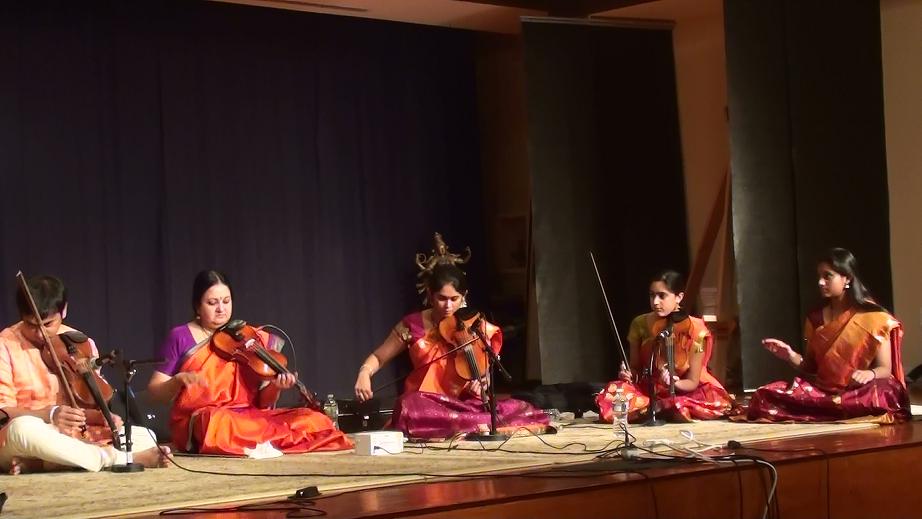Contribute
| Guru-Sishya Parampara In Performance |
Sunanda Narayanan
02/13/2013
(This article is sponsored by Masala Art)
Creating a sishya parampara (student lineage) is a core aspect of the classical Indian performing arts. It is well known that Saint Tyagaraja had a large retinue of devoted sishyas thanks to whom we have access to his compositions today. It was, but, befitting that to celebrate the Jayanthi of the great saint, the Chinmaya Mission of Boston presented a performance featuring Gurus and Sishyas together on stage on Saturday, February 2, 2013. It was heartwarming to see the teachers and students perform with little hierarchy, sharing stage space and, more importantly, music on an equal footing.
Crowning a day-long lineup of performances by the students of Boston-area music teachers, Guru Tara Anand, who is well known in the Greater Boston area for her proficiency both as performer and teacher, showcased three of her senior violin students – Suhas Rao, Rasika Murali, and Sahana Srinivasan in the featured recital that evening. Tara’s senior vocal student, Pavithra Devarajan, kept the talam during the recital – a key role in an instrumental group program where synchronization is a vital ingredient for harmony. It was lovely to see senior mridangam Guru Pravin Sitaram on stage along with his talented student, Tarun Bangalore (also Guru Tara’s son), providing subtle yet effective percussive support.
The recital opened with the traditional Nattaikurinji padavarnam “Chalamelaâ€, played in two speeds with perfect coordination by the artists. The ‘odhukkal’ (offbeat variation) and emphasis on certain syllables of the lyrics in sections of the sahityam were delectable.
Following this sprightly start, came the regal Muthuswamy Dikshitar composition “Sri Mahaganapatim†in Gowlai ragam. The kriti rendering was languorous and one could visualize the elephant-faced Nardhana Ganapati (dancing form of Ganesha) in the Chittaswaram, dance as it did on the fingers of the violinists. The kalpanaswaras were vibrant , with the Guru and students enjoying an easy camaraderie in their individual forays. Tara and Suhas provided a neat climax with a catchy koraippu.
Another Dikshitar composition in the rare raga Ravi Kriya, ‘Himagiri Kumari’, ensued and was a bhakti-filled rendering in praise of Goddess Brihadeeswari.
Abhogi came right after like a refreshing breeze – familiar, yet with teasingly innovative phrases from the four artists, each of who played a section of the alapana. It was almost like seeing a story written by multiple authors, each handling a chapter. What was amazing that the alapana carried the coherence of Tara’s inimitable style, while still giving sneak peeks into the aesthetic values of each artist. The moving Gopalakrishna Bharati kriti “Sabhapathikku Veru Deivam†was played with particular sensitivity to the lyrics. In the line “Oru daram Shiva Chidambaram Enru…â€, the violins enunciated the words with deep poignance, and the closing variation of the Pallavi line “Samaanam Aaguma?†after each section of the kriti was simply outstanding.
“Entha Muddo†in Bindumalini – a composition of Saint Tyagaraja was a charming interlude between Abhogi and the elaborate presentation of “Kanta judumi†in Vachaspati. The intrinsic flavor of Vachaspati was carried right through the exposition, which is sometimes tricky given how close this raga is to Latangi. A whiff of “Paraatpara†and the lovely phrase “DSND PNDP M,M,…†in the alapana from Tara were fetching touches. Neraval at “Ala Nadu Saumitri Pada Seva†was again a group effort. You could hear the lyrics all through the neraval, which helped sustain the emotive thread. The kalpanaswaras, both in this song as well as in “Sabhapathikkuâ€, showcased the technical virtuosity of the Guru and the Sishyas with patterns building on and rivaling each other in complexity. The handoffs were smooth, the muthaippu (final flourish) exciting, and above all, it was gratifying to see the mutual appreciation of each other’s effort.
Guru Pravin Sitaraman and Tarun’s mridangam tani (pure percussion exercise) for this piece was wonderful. While their mridangam accompaniment for every piece impeccably embellished the sangatis as well as manodharma aspects of the compositions, it was in this duo routine that their prowess was in full evidence. The initial vinyasa (elaboration) section included an attractive tisram variation and was followed by the customary kuraippu, mohra, and korvai segments. The cadence of the two mridangams, sometimes alternating, and at other times playing in unison was arresting.
Kanakadasa’s classic piece – “Krishna Nee Begane†was soulful and captivating. A kavadi chindu medley followed and it was a garland of vivacious melodies played with relish. The final piece, a rare tillana in Behag by Harikesanallur Muthaiah Bhagavatar, was a brisk and lilting culmination to a stunning recital.
Sahana’s striking talent, Rasika’s deep emotive involvement and technique, Suhas’s virtuosity and poise, Pavithra’s composure and confidence in keeping rhythm, and Tarun’s innate musicality must have surely made their Gurus well up with pride, apart from of course the sheer joy it brought to the listener. One could only marvel at the effort these students have put into their training over several years and the generosity of their wonderful teachers in sharing their knowledge.
This concert demonstrated in practice the best values of our performing art traditions –strong work ethic, discipline, humility, and a deep respect for the Guru, the musical tradition, the co-artists, and last but not the least – the audience. Kudos to the team! We hope to hear these Gurus and their disciples in many more concerts in the Boston area in the near future.
You may also access this article through our web-site http://www.lokvani.com/

